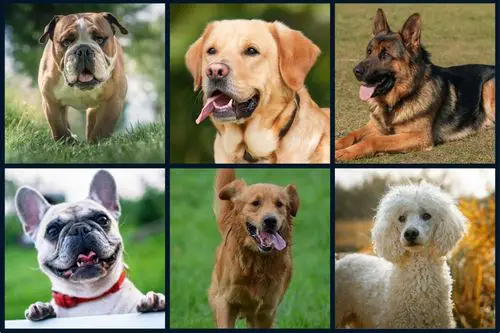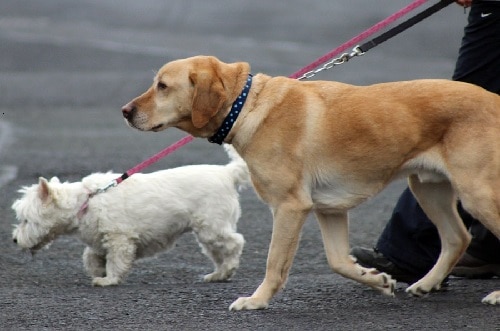We all know exercise is essential for dogs to stay fit, healthy, and happy. But some breeds will need more than others. For example, a Bulldog and a Labrador Retriever don’t require the same amount and type of exercise. So you have to consider the breed when it comes to physical activity.
Dogs need anywhere from 30 minutes to 2 hours of exercise per day. It’s a wide range, but the breed will help you narrow it down. Some dog breeds are more active than others. So this factor can help you find how much exercise your dog needs.

List Of Popular Dog Breeds Exercise Needs!
The FCI recognizes over 360 dog breeds, while the AKC has more than 195 recognized breeds. Either way, that’s a lot. So I’ve decided to include only the most popular dog breeds in the table below. Here’s approximately how much exercise each dog needs by breed!
Disclaimer: The recommendations above are not medical advice. It’s only general information to give you a better idea of how much exercise each breed needs. Every dog is different and has unique requirements. So you should not only consider the breed, and the numbers in the table above might not be accurate for your dog.
I found the information above through quick research on the breed and its exercise needs. I also used my common sense and knowledge because there were often many sources with different recommendations.
How Much Exercise Does A “Dog Breed” Need?
If the dog breeds you were looking for aren’t in the table above or you want more information about their exercise needs, you can always do more specific research on your part. By typing “How much exercise does a *insert the dog breed* need?” on Google or any other search engine, you should have many results to look at and read.

Which Breed Of Dog Needs The Most Exercise?
High-energy sporting and working breeds are generally those who need the most exercise. It includes Retrievers, Shepherds, Collies, Spaniels, and Pointers. Bred for jobs that require a lot of physical effort and endurance, they are more active than other dogs. So they will need more exercise.
List of Dog Breeds That Need A Lot Of Exercise!
- Labrador Retrievers.
- Golden Retrievers.
- Australian Shepherds.
- Border Collies.
- German Shepherds.
- Dalmatians.
- German Shorthaired Pointers.
- English Springer Spaniels.
- Boxers.
- Siberian Huskies.
Which Breed Of Dog Needs The Least Exercise?
Toy and non-sporting breeds usually need the least exercise because of their size, shape, or temperament. Lazy hounds and terriers will also not require a lot of physical activity. Bred as companions, many of those breeds have become couch potatoes. Very big and large dogs also tend to need less exercise.
List of Dog Breeds That Needs Little Exercise!
- English Bulldogs.
- Chow Chows.
- Basset Hounds.
- Shih Tzus.
- Dachshunds.
- Pugs.
- Chihuahuas.
- Bullmastiffs.
- Tibetan Mastiffs.
- Cavalier King Charles Spaniels.
Even if those breeds need less exercise, they still need some. All dogs must do physical activity to stay healthy, fit, and happy regardless of how lazy they are. So make sure to provide them with enough exercise, but not too much.
How Much Exercise Do Certain Dog Breeds Need?
Most dogs need at least 30 to 60 minutes of exercise per day. But certain breeds will need more or less than that. It will depend on many factors, including the group, origin, energy, fitness level, and size. Here’s more information to help you understand how much exercise a specific dog should get.
Breed Group
There are different groups of breeds, more precisely 7 according to the AKC. It includes the sporting, non-sporting, working, herding, hound, terrier, and toy group. Each group contains breeds with a similar original job.
So the group can give you an idea of how much exercise a given breed needs, but it’s not always accurate. As I already said, sporting and working dogs (including the herding group) usually have more stamina and energy, while non-sporting and toy breeds tend to be less active.
However, there are some exceptions. Besides that, how much exercise a breed needs will vary a lot, even in the same group. For example, the Beagle and Dachshund are both in the hound group, but their activity level differs considerably. That’s why you should also look at the specifics of the breed.
The Breed
Each dog breed is unique mainly because of its origin. They were all bred for specific purposes, which makes them who they are nowadays. So analyzing the breed will tell you a lot about a dog and his exercise needs. Let’s take some examples:
Labrador Retrievers
Labs were originally bred by fishermen to retrieve fish or other objects from the water, haul ropes, and assist them in their work. So they used to swim and be active all day long. Then, it became a popular gun dog for hunters and companions for families. That’s why Labradors need a lot of exercise.
German Shepherds
The German Shepherd Dog was initially bred as a herding dog for sheep. But it quickly became a versatile working breed for assistance, search-and-rescue, police work, and much more. So it can explain why GSDs need to be kept busy and active as companions.
Bulldogs
Bulldogs were bred to control livestock and compete in the bloody sport of bull-baiting. Once this practice was outlawed, they were still used to herd hogs and cattle. However, as Bulldogs became popular pets, they quickly became lazy couch potatoes that don’t need much exercise.
Beagles
This breed was originally bred as a scent hound to hunt mainly rabbits and hares. So Beagles used to track and chase small prey for long periods. That’s why they have so much energy and stamina for their size. It makes the Beagle an active dog that requires quite a bit of exercise.
Rottweilers
Rottweilers were bred to be herding dogs but were also used to pull carts and protect their owners. Therefore, this is a very versatile working breed. Driving cattle and hauling loads is physically demanding, which can explain why Rotties are muscular and energetic. But some became guard dogs or couch potatoes that need less exercise.
Energy & Fitness Level
Certain breeds naturally have more energy and are in better physical condition than others. For example, Australian Shepherds are generally hyperactive and fit, while Basset Hounds are more likely to be lazy and get overweight. So the level of energy and general fitness is another factor to consider.
Even if it can vary from one dog to another, some breeds tend to be more active and in better shape. The more energy a breed has, the more exercise it should get. The physical condition can also influence how long it will take for the dog to be satisfied or tired out.
Size
When it comes to exercising a dog, the size might have an impact. In general, small and toy breeds require less exercise than medium and large ones because they must put in more effort for the same result. Here’s an example to prove my point.
Let’s say you walk two dogs at the same time. One is very small, and the other is medium-large. At equal activity level and exercise tolerance, the smaller one will be satisfied and tired out more quickly because he has to do more steps than the bigger one.
But it’s not a hard rule because some tiny dogs are much more active than larger ones. For example, Jack Russell Terriers have a lot of energy and need a lot of exercise, even if they are very small. Many medium and large breeds wouldn’t be able to keep up with them.
On the other hand, giant dogs also tend to be less active. Great Danes, Newfoundlands, St. Bernards, and Bullmastiffs don’t need that much exercise despite their massive size. So bigger breeds don’t necessarily require more physical activity.
What About Mixed Breeds?
Mixed breeds are a cross between two breeds or more. So every mutt is unique and unpredictable. You can still take the exercise needs of the breeds involved in the mix to have a better idea of how much exercise a non-purebred dog should get.
For example, let’s take the Cockapoo. It’s a mixed breed between the Cocker Spaniel and the Poodle. They are both relatively active and energetic. The Cocker Spaniel will need around 45 to 90 minutes of exercise per day.
On the other hand, the Toy or Miniature Poodle, which is what a Cockapoo is practically always bred with, only requires around 30 to 60 minutes. So it’s a good idea to provide this mixed breed with about 45 minutes of daily exercise. But some Cockapoos might need more or less than that.
Learn more about the Cockapoo exercise needs!
However, it’s not always accurate, and it can be overwhelming if many breeds are involved. Therefore, you might have to ignore the breed and focus on the dog instead. Analyzing the fitness and energy level will give you an idea of how much exercise a mutt or certain breed needs.
Other Factors That Can Influence Your Dog’s Exercise Needs?
Apart from the breed, many other things will determine how much exercise a dog should get. Even if dogs from the same breed have similar traits and temperaments, they are still all different and unique. So here are other factors you should consider.
Age
How old the dog is will influence how much exercise he can take and need. Puppies and seniors won’t have the same requirements. The general recommendations above referred to the breed at an adult age. If a dog is young or old, his exercise needs will vary and usually be lower.
Health
Health is another essential factor to consider. Some dogs have special conditions or problems that can influence their exercise requirements and tolerance. That’s why it’s always a good idea to consult a vet for a health check. The recommendations above referred to healthy dogs of the breed.
Line
The dog’s lineage can also have a huge impact on his exercise needs. Working lines are usually more high-energy and athletic, requiring more physical activity. On the other hand, show lines are much calmer and need less exercise.
Dog
The ultimate solution is to observe the dog and use your common sense. Does he have a lot of energy? Is he getting tired quickly when exercising? Does he seem bored or overweight? … Then, you should be able to find out how much exercise your dog needs.
Last Thoughts About Dog Breeds Exercise Needs!
Finally, the breed of a dog will give you an excellent idea of how much exercise he should get. Dogs of the same breed or group have similar origins, energy, fitness, and size. All that information will influence how active they are and how much exercise they need.

Besides that, you should also consider the dog itself, including age, health, and line. Dog breeds can require anywhere between 20 and 120 minutes of exercise per day. So I hope my article has helped you find out how much exercise each of them needs and understand why.
Let’s Exercise That Dog According To His Breed!